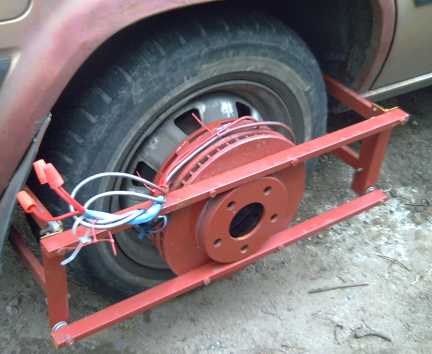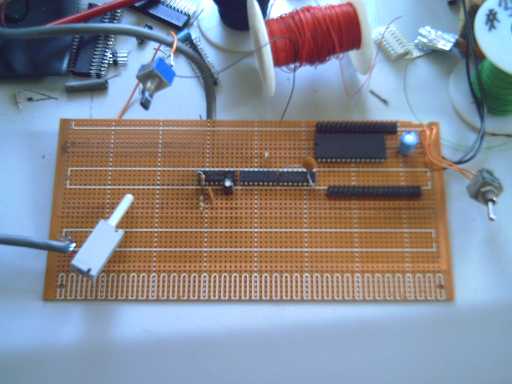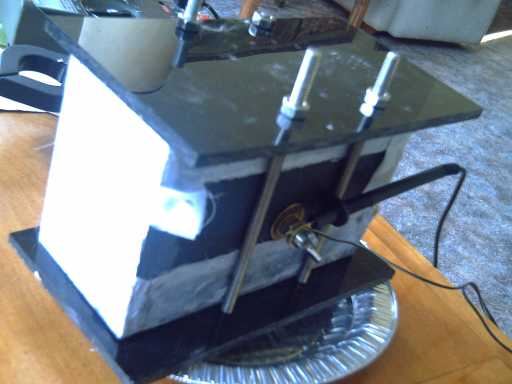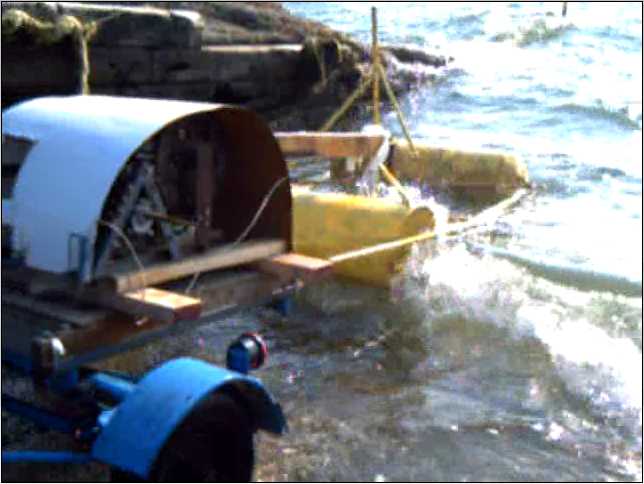Turquoise Energy News
#3
Craig Carmichael May 1st,
2008
It's been a while, so here's an update!
All the energy related projects I started seem to be progressing
well, and everything seems to be on the verge of going, almost all at
the same time. The first sealed Ni-MH Turquoise BatteryTM is made and the first Electric HubcapTM motor is mounted on my car. There are good chances
that all the designs including the ocean wave power mechanism
will pass basic operating tests in the next month or two.
I hope I haven't put in too much boring detail. Anyway, there are
a few fotos to look at for relief.
Contents
Technology Exploitation
The Electric HubcapTM Drive
Motor
Turquoise Motor Controller
Turquoise BatteryTM
The Wave Power Machine
Technology
Exploitation
The Electric hubcapTM
vehicle drive motors are unique and seem to me to be the most
practical way to turn existing cars into plug-in electric hybrids. I'm
making an economical solid state dual motor controller that can offer
valuable custom features in preference to purchasing high priced
generic controllers. What can better be said about the Turquoise
BatteryTM than that it appears it could
be the battery everybody's been wanting for decades, to ditch those
heavy, bulky lead-acid batteries for all uses.
Inventions and new products are of little value unless they are
used in some way. Anyone is welcome to propose something, otherwise
for consideration here are two options I'd go for:
1. Turquoise Energy can be funded to set up manufacturing
facilities and to market the product(s). A division could be set up
for each product to be produced (according to the amount of investment
and the priorities of the investors after consultation with me):
Motor-Generator Division (starting with the Electric Hubcap motors),
Batteries Division, the Plug-in Hybrid Car Conversion Kit Division
that puts all the pieces into a working garage/consumer installation
package, and the Wave Power Division. An administrative branch will
doubtless also be required. I would expect revenue in each department
should begin to trickle in pretty soon unless there are regulatory
hurdles, which should grow gradually with expanding experience and
production facilities.
As an R & D person, an inventor and product developer, if I
am president I will hire the best talent I can find, and I myself will
be an active participant in the operations only for as long as it
takes to get each division set up and running smoothly, at which time
a divisional operations manager will be elected (naturally by choice
ranking, so-called "STV", voting) or otherwise chosen for a
two year term. I see great value in giving employees a say in choice
of their supervisors and in limiting the terms of supervision. It
inherently avoids the "Peter Principle", large severance
settlements and claims of "improper dismissal", etc. to get
rid of someone who isn't performing well, ends employee burnout, and
will allow fresh talent, experience, tact and other good management
qualities to rise naturally to the fore. No one can feel they've been
unfairly overlooked, or people with valuable skills be shut out from
promotions just because someone else is "in there for life".
Various employee democracy protocols (always subject to veto by
management or the board of directors, who may also have votes even if
they decline to veto), should make the company somewhat
self-governing, eliminate uncooperative employees, and establish a
valuable team spirit.
Turquoise Energy Limited is incorporated as a privately held BC
company. Shares are $10 each.
BTW I see value in the name "Turquoise Energy", which
name I rather stumbled across in the form a large turquoise plastic
water pipe when I was looking for an enclosure for the wave power
unit's electric generator. It's sort of like "Microsoft" or
"General Motors" in the "green energy" field: it
says it all and it will draw attention naturally.
2. Alternatively, I will consider selling the inventions outright
if good offers are forthcoming. (But please don't expect to buy one of
these ground-breaking products for just a few thousand dollars -
getting to this point has cost me much more than that in years and
efforts.) Buying the product(s) will get you all I know on the subject
of the product in question, and I will help plan and set up (locally)
the manufacturing facility if desired. I have many thoughts about
various potential techniques for production for all the products. I
have no special talents to offer at sales or marketing (though my
brother Ian, also in Victoria, does).
The Electric
HubcapTM Drive Motor
Electric Hubcap Motor Factoids:
- The motor itself has no moving parts: only the car's wheel
turns.
- There are no connections with or changes to the car's existing
mechanical components and systems.
- For 13 inch wheels, the RPM is about 10 per one kilometer per
hour of speed, that is, 450 RPM at 45 Km/Hour. Most electric motors
prefer much higher speeds, but the "Hubcap" has good low RPM
torque and power. 120 Km/hour is just 1200 RPM, thus no gearing or
transmission is needed.
- When not in use, the motor has no more effect on the car than
any other 40 pounds of luggage.
- The motor sticks out less than 4" from the wheel (and
could be made thinner if necessary). This is less protrusion than the
outside rear view mirror.
- The motor has an RPM sensor coil and an IC temperature sensor
(AD590) built in to ascertain actual speed and to warn of any overheat
condition ("yellow alert" and "red alert" lights
or an LED bar thermometer.)
- It's air cooled. I have a vague idea it will get pretty hot
driving a car up a mountain. I have a new idea for "porous"
polyester resin that should greatly improve the stator's internal
cooling, that I hope to try out on the second motor.
The first electric hubcap has been mounted on the car. Tests as a
simple PMG generator showed reasonable voltages and currents for the
one rotor implementation, but lower than originally planned, as it was
originally to have two magnet rotors. But the specs of torque,
horsepower, the optimum battery voltage and the electric current
required have yet be be worked out regardless. Actual performance
testing as a motor awaits the completion of the controller, and
actually going somewhere will need to also see enough batteries to run
it.
First Electric HubcapTM drive motor on my so-called car.
Stud extensions mount the NIB supermagnet rotor
to the wheel, while the stator bracket attaches to the rear of the
brake drum housing.
It needs a nice fairing to cover up the
ugliness. Oh... and cables into the car.
Turquoise Motor
Controller
Three-fase AC motors such as the electric hubcap can't run
directly off of batteries. Instead, a solid state controller converts
the DC power of the battery into variable frequency AC power.
Not having designed any electronic circuits for many years, I
must remark here what a treat it is today, to find semiconductor
datasheets and application notes readily available on line, and fast
tech support direct from the manufacturers, instead of scrounging
around for info and specs. I would have made poorer choices without
this excellent new info network!
The AC power frequency creates a rotating magnetic field in the
motor that turns the magnet rotor and determines the car's speed.
Increasing the frequency above the wheel's current speed causes
acceleration and the motor uses energy from the battery. Conversely, a
lower frequency causes deceleration, dynamic braking, which generates
energy, which goes into charging the batteries. Some experimentation
may show that the motor will perform acceptably at any nominal voltage
from 72 to 144 volts, and can be coaxed into recharging the batteries
while driving any fair driving speed on gas fuel.
There's a lot of talk about it being hard to get regulatory
approval to run an electric car above 40 Km/H. This design blurs the
boundaries: it changes nothing of the vehicle (beyond adding about the
weight of a passenger), which is already approved for driving at
highway speeds. Is a car, approved for highway travel, to be
restricted to 40 Km/H when using one fuel (the safer one) but not when
burning flammable liquid?
Furthermore, the dynamic braking effect means that as soon as the
driver takes his foot off the gas, the car is being slowed down, akin
to gearing down. This is safer than the usual system because accidents
usually happen very quickly. In an emergency, the car already begins
slowing before the driver can get his foot to the brake pedal. And it
is safer for lesser related control reasons which I won't detail
here.
If we have an existing safety approved car and an add-on system
making no mods to that car (besides drilling a few mounting holes and
intercepting a couple of electrical circuits to enable proper
switching between gas and electricity), and that is actually safer to
drive with than the gas engine, it would be negligent of regulators
not to grant approval as quickly as due diligence allows.
The motor controller board. So far it generates
the variable frequency 3-fase drive as digital signals (grey sliding
potentiometer on left goes under gas pedal) and has On-Off (right
switch) and forward-reverse (blue switch).
...My, don't those controls look
"industrial"!
It remains to interface the MGD driver chip
(the big one: IR2130 from IR, it simplified the whole design) to the
power MOSFETs to drive the actual motor coils. (MOSFETs are still on
order, sigh!) Top header strip is to the MOSFETs; lower one is to the
dashboard panel for the "nut behind the wheel".
Turquoise
BatteryTM
The first sealed Turquoise Battery has been made. Some
time-consuming internal chemistry took place, but now I'm testing it.
I didn't previously understand the need to SEAL the batteries very
solidly, like little space ships. Ni-MH is not the same as lead-acid:
there's internal pressure when they're charged, the "equilibrium
plateau pressure" of the hydrogen in the metal hydride. I thought
this battery was well sealed in ABS plastic, but there were some thin
joins, and the power of the battery to find pinholes or make them in
weak spots is amazing. When I got those sealed, by fairly extreme
measures, everything started to bulge, and I began to wonder if the
whole thing would burst. So I armored it with some reinforcing plates.
(See lower picture!) I have no pressure meter, so I'm guessing when I
say it's 10 to 20 PSI, on the high side but still a typical battery
metal hydride pressure.
It's in its initial "electrophoresis/internal chemistry
forming" stage. From previous ones I've taken apart again, I know
there's some good stuff happening inside, and I'm pretty sure the
chemistry should be good, but so far I'm disappointed by the voltages
and currents I'm seeing and I'm wondering if I've missed
something.
It's 3 x 4 x 6 inches, and weighs 5 pounds. (Nominally 6.25V. It
looks like it should be about 25 amp hours. It should be easy to
increase that - my electrode proportions were a bit off and the nickel
hydroxide powder was evidently packed too loosely. (too little weight
per volume.) I'm thinking of possible ways to "crunch" it
down better.)
Specs are good to designers, but perhaps for most people it's
more enlightening to say that, being Ni-MH, bipolar flat plate, and
assuming it finally works, this looks like much the best battery so
far for electrifying cars. It will keep the designs simple (eg, it
should have no use for "supercapacitors"), it should be
economical, and one sufficient for tens of kilometers of driving will
weigh 100 pounds and take up the trunk space of a spare tire.
The several small but useful innovations in the Turquoise Battery
may set some new standards for battery making. Perhaps especially of
note, by creating a new ABS plastic working technique, by sealing with
polyamide, and by an outside shell, I seem to have found a good way to
pressure seal flat plate bipolar Ni-MH batteries, thus making bipolar
the battery layout of choice, a feat no previous manufacturer seems to
have managed.
I've made all these nice battery breakthroughs in just four
months. It's taken much of my time, a lot of research and creative
thinking, extensive previous product design and fabrication
experience, financial risk, luck, and seemingly divine guidance! A
great deal is also owed to previous battery and other experimenters
who have placed their work and results on record over the decades, and
it certainly couldn't have been done without the power of the internet
to quickly seek out and view these valuable writings.
Turquoise Battery Factoids:
- Bipolar Flate Plate design with thick powder/paste electrodes
and a single thin metal plate separating the stacked cells. This
design has the highest intrinsic energy density for its size and
weight and the highest amperage for power delivery when it's needed
and for rapid charging.
- The intractable bipolar flat plate cell edge leakage problem
has been solved by encasing the entire battery in ABS
plastic....
- A new method of working with ABS has been developed to enable
the above encasement, which might otherwise be impractical.
- This battery is neither alkaline nor acid; it is neutral. The
electrolyte is a common "green" ingredient.
- All the ingredients are environmentally benign,
"green".
- The positive electrode is the common beta nickel [oxy]hydroxide
(which powder is turquoise in colour, and the paste formed is
literally green - surely a selling point), but there are
additives...
- A couple of them are added by a unique new phoresis technique.
A possible new field of battery chemistry has been opened by the
unique choices of materials.
- The hydrogen storage hydride (negative electrode) is a new
formulation with never before used ingredients intended to achieve
higher power, dense hydrogen storage and longer life...
- My technique for chemically combining the "incompatible"
hydride ingredients has to be seen to be believed!
The 6V sealed Turquoise Battery as first
made.
The other terminal is of course on the far side
of the battery, whose 5 cells are stacked like slices of bread in a
loaf.
The armored battery after various exertions to
stop leaks and bulgeing.
The Wave Power
Machine
Minor technical glitches and issues (and admittedly being more
enthused by the other projects) have prevented a successful test thus
far, but it's certainly coming. Slightly bigger waves at the last
trial would probably have spun the generator. If I turned it by hand,
a couple of times it sped up as a wave hit. I have since increased the
magnet gaps in the generator to reduce the startup torque needed. A
better gear system (less friction) might also have made the
difference.
Tests are at nearby boat launches where I can easily access the
shoreline with the machine. The rarity of suitable winds/waves ensures
tests are few and far between, causing progress to be measured in
weeks - even months - instead of days. (Naturally, boat launches are
located in the most sheltered spots rather than the most open.)
Wave Power unit floats rocking in the waves at
James Bay Anglers boat launch, April 17th
The potential start of a potentially billion dollar sustainable
wave energy program and ultimately reversing the flow of power between
Vancouver Island and the mainland hinges on this tiny but vital detail
of initial "proof of concept" technical success.
Being sure myself that's coming, to my mind, the exploitation of
wave power hinges on:
(1) the confidence and will by those having resources to
invest in a production prototype using any working, economical and
practical wave power capture mechanism, and to install it and connect
it to the power grid, then to invest in and proceed with initial large
scale production and deployment on the west coast. (Eg, selecting
sites from Jordan river to Tofino.) Then it will be obvious to
everyone that all that's required is to build more and more until
we're getting as much power as we want to harness in this manner,
which will be a lot of power.
I delayed a year and more on making a prototype, and very nearly
abandoned the project entirely, as most of my "feelers" and
enquiries in various directions met little response. I thought this is
what everybody wants. Why labour over a great design if it looks like
no one will bother to do anything with it once it's working?
(2) the provincial government's hearty cooperation in
granting permits to anchor the units near the shore and allow creation
of on-shore connection sites. These will probably amount to power
poles above the maximum high water line with locked electrical
equipment boxes at the base and a conduit under the beach into the
sea. Even if there's one per kilometer, to harness an entire shoreline
some of the units will need heavy undersea power cables over 1/2 a
kilometer long. (BTW: The idea of somehow storing the immense
generated energy of waves onboard the floating units in any form for
periodic collection by vessels is preposterous. Wave power simply
won't happen without shoreline connections.)
(3) BC Hydro's permitting grid hook-up of the generators. I
would presume this would be forthcoming if everything else is in
order.
Here on the BC coast we have some of the best conditions on the
planet for utilizing wave power. Under current rules, it would seem
the best way to use the wave power is to set up an independent power
producing (IPP) company and sell electricity to BC Hydro for a lower
rate than all the competing technologies. Ultimately, the flow of
electricity between mainland BC and Vancouver Island can be reversed
with enough units "swimming" just beyond the kelp off the
island's west coast.
To me the technical issues appear to be largely secondary, though
no doubt each of the first few units will see various design and
layout improvements in each successive construction as experience is
gained. (I'll already be trying a layout variant on the prototype's
next test.) Myself, I have in mind low maintenance, virtually
unsinkable and unflippable ferrocement and styrofoam
"starfish", with five power capture float units (of like
materials) on arms spreading out from each of the five sides. (Perhaps
some of those who, like me, think they have better designs, can be
encouraged to try theirs out on one or more arms of the prototype
units. May the best design(s) win!)
http://www.turquoiseenergy.com
Victoria BC





